Article
Effects of atorvastatin on serum lipids, serum inflammation and plaque morphology in patients with stable atherosclerotic plaques
- Authors:
- Suxia Guo
- Ruxing Wang
- Zhenyu Yang
- Kulin Li
- Qiang Wang
-
View Affiliations / Copyright
Affiliations:
Department of Cardiology, Affiliated People's Hospital of Nanjing Medical University, Chong'an, Wuxi, Jiangsu 214023, P.R. China
-
Pages:
1069-1074
|
Published online on:
September 25, 2012
https://doi.org/10.3892/etm.2012.722
- Expand metrics +
Metrics:
Total
Views: 0
(Spandidos Publications: | PMC Statistics:
)
Metrics:
Total PDF Downloads: 0
(Spandidos Publications: | PMC Statistics:
)
This article is mentioned in:
Abstract
Statin treatment in patients with coronary heart disease is associated with a reduced incidence of short‑term adverse events and endpoint cardiac events. However, the effects of statin treatment on atherosclerotic plaques, particularly stable plaques, remain poorly defined. In total, 228 consecutive patients with stable atherosclerotic plaques who had undergone coronary arteriography (CAG) and intravascular ultrasound (IVUS) were randomly assigned to receive placebo (placebo group, n=54) or atorvastatin (ATOR) at a single daily dose of 10 mg (ATOR 10 mg group, n=47), 20 mg (ATOR 20 mg group, n=45), 40 mg (ATOR 40 mg group, n=43) or 80 mg (ATOR 80 mg group, n=39). Endpoints, including serum lipids, serum inflammation, plaque volume and percentage of plaque necrosis were assessed after 3-6 months. At baseline, mean low-density lipoprotein (LDL), high-density lipoprotein (HDL) and high-sensitivity C-reactive protein (hs-CRP) levels, as well as plaque volumes and percentages of plaque necrosis, were similar between all groups. At 6 months of follow-up, the LDL levels in the ATOR groups were below those at their respective baselines (P<0.01). HDL levels in the ATOR 80 mg group following treatment were significantly higher compared with baseline (P=0.001). Additionally, they were significantly higher compared with those in the placebo, ATOR 10, 20 and 40 mg groups (P<0.01, P=0.001, P=0.048, P=0.047, respectively). Hs-CRP levels in the placebo group following treatment were higher compared with baseline levels (6.87±2.62 vs. 5.07±1.80, P<0.01), but hs-CRP levels in the ATOR 80 mg group following treatment were lower compared with baseline (3.59±1.07 vs. 6.10±2.12, P<0.01). According to the virtual histology (VH) of IVUS, the percentages of plaque necrosis following treatment in the placebo and ATOR 10 mg groups rose above baseline levels (15.51±12.56 vs. 7.69±1.31%, 13.54±11.76 vs. 7.83±1.43%, P<0.01) and conformed to the diagnostic criteria for unstable plaques (15.51±12.56, 13.54±11.76%). By contrast, in the ATOR 20, 40 and 80 mg groups, percentages of plaque necrosis remained stable following treatment compared with baseline (P=0.069, 0.846 and 0.643, respectively). Plaque volumes following treatment in the placebo, ATOR 10 and 20 mg groups were similar to baseline levels. However, in the ATOR 40 and 80 mg groups, plaque volumes decreased following treatment compared with baseline plaque volumes (30.69±8.12 vs. 37.09±12.01 mm3, 24.99±1.01 vs. 36.47±14.68 mm3, P=0.019, P<0.01, respectively). ATOR (20 mg/day) is able to lower LDL to standard levels while ATOR 40 mg/day was superior to 20 mg/day and had similar effects to 80 mg/day. Only ATOR 80 mg/day was able to increase HDL levels. Hs-CRP in patients without ATOR was higher and ATOR 80 mg/day decreased levels. ATOR ≥20 mg/day is able to stabilize plaques and ATOR 80 mg/day was superior to 20 and 40 mg/day. Thus, ATOR 40-80 mg/day reduces the volume of plaques.
View Figures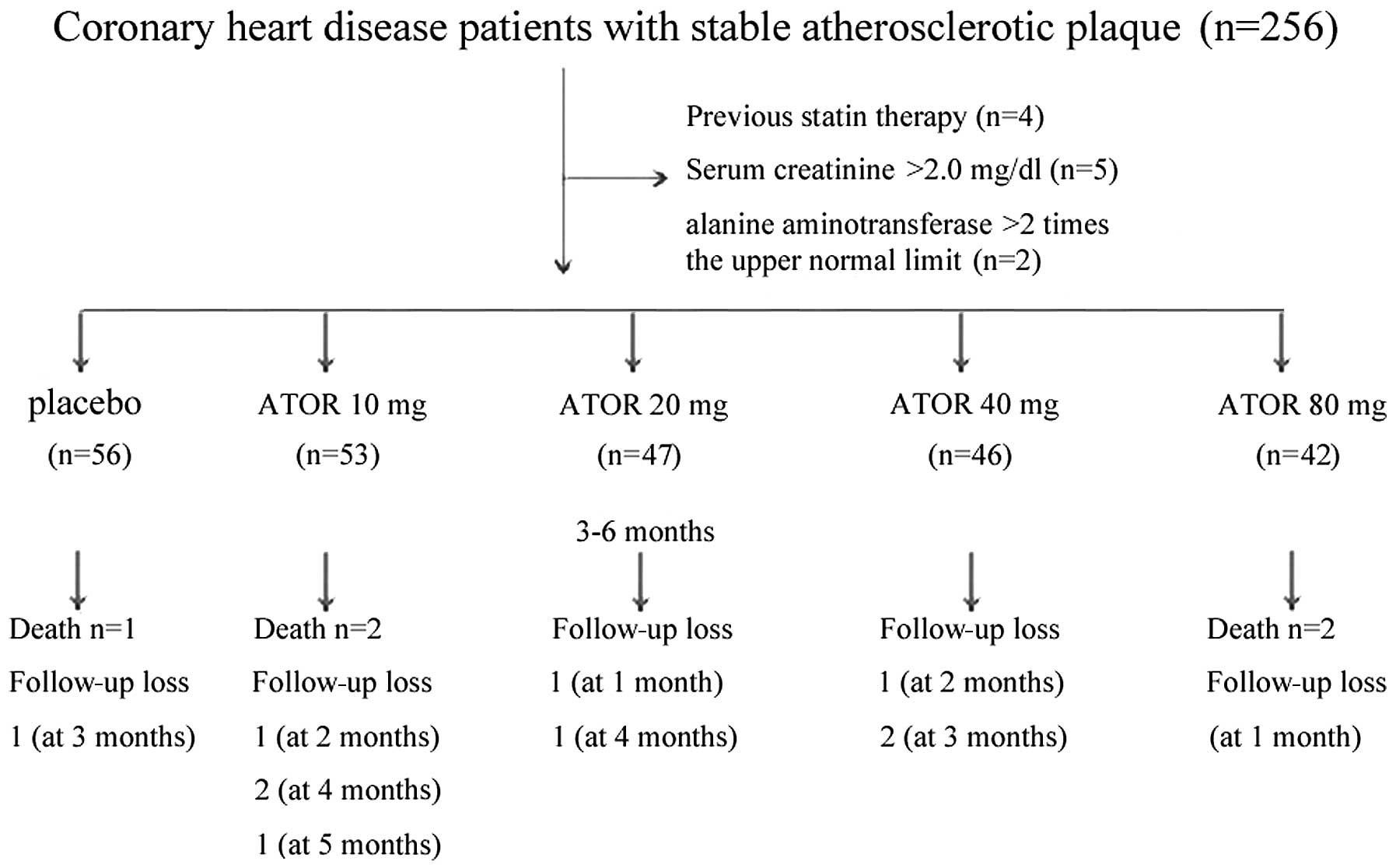 |
Figure 1
|
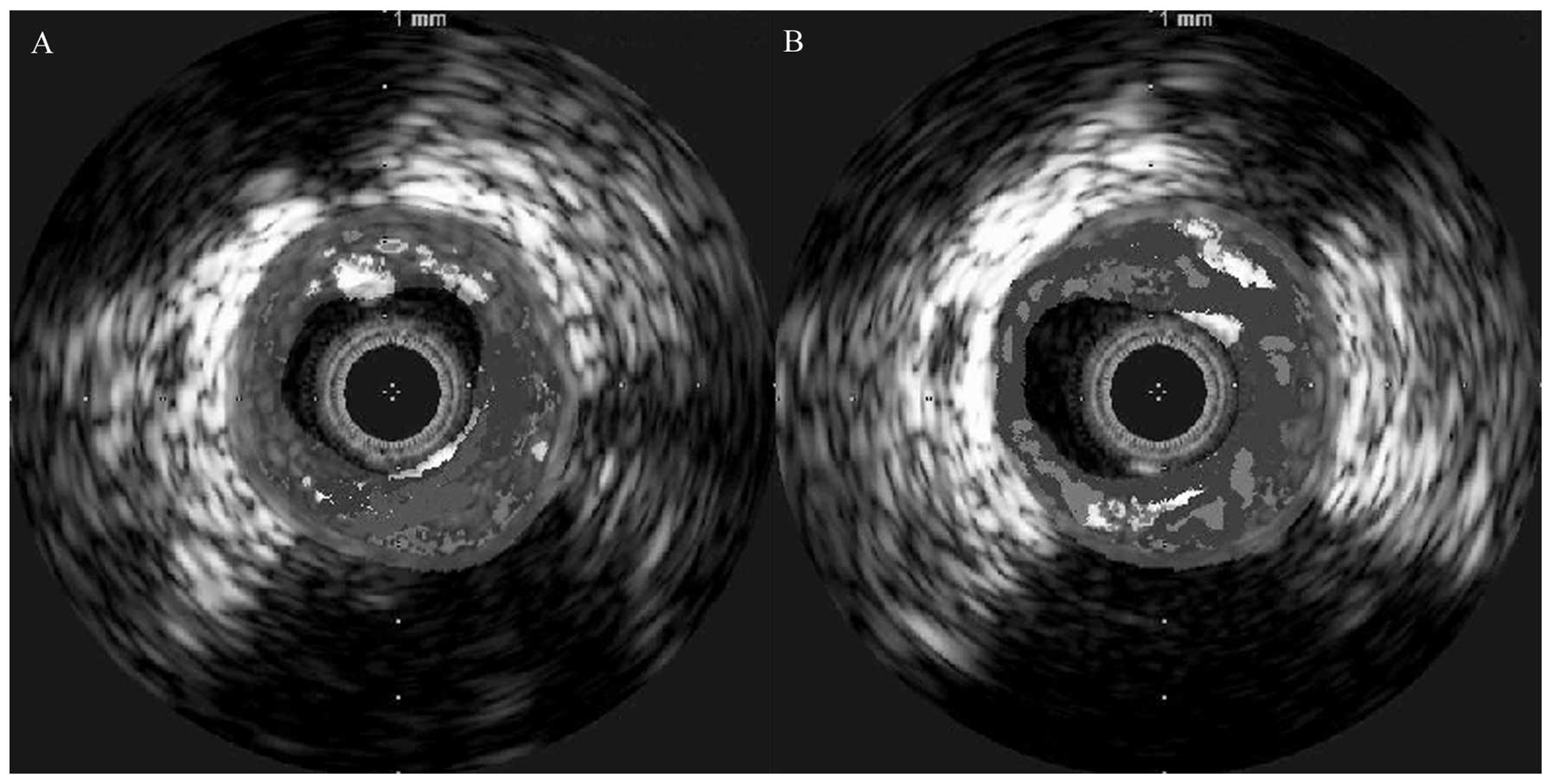 |
Figure 2
|
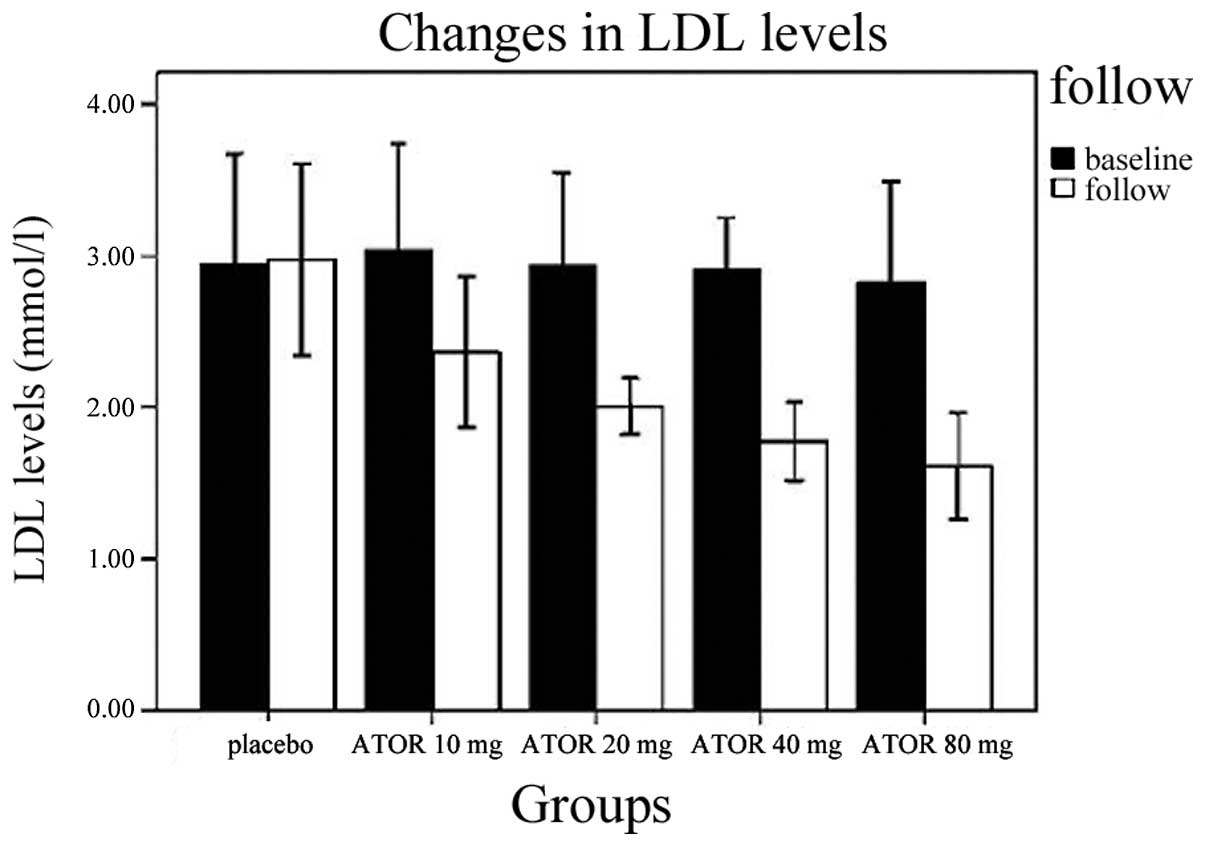 |
Figure 3
|
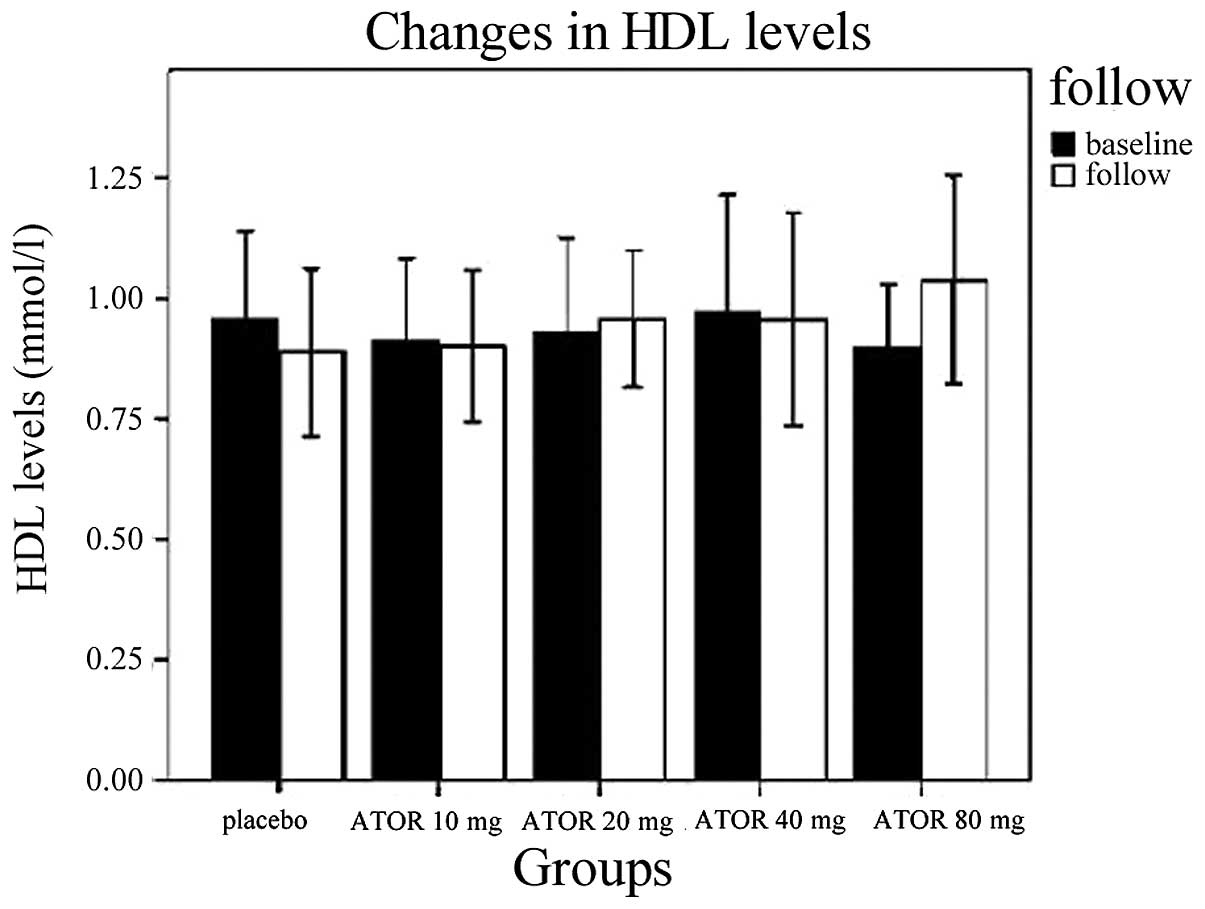 |
Figure 4
|
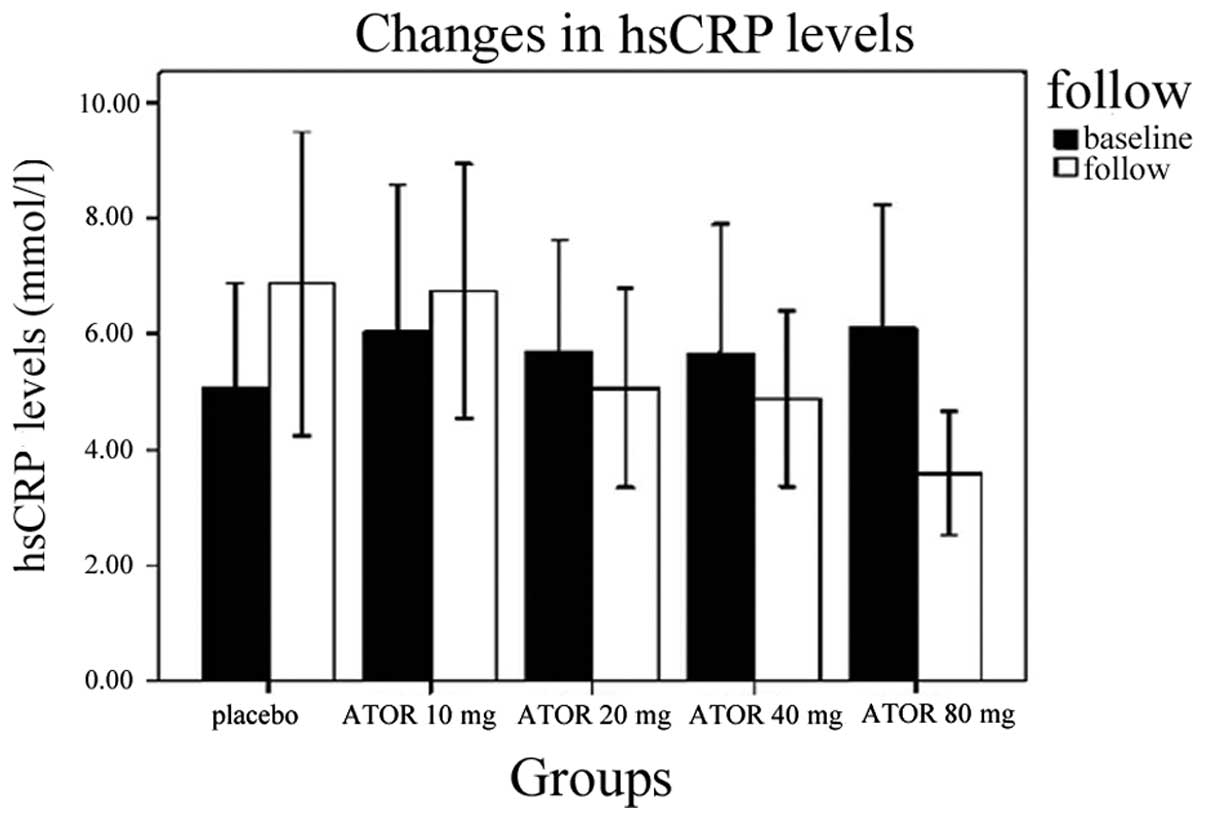 |
Figure 5
|
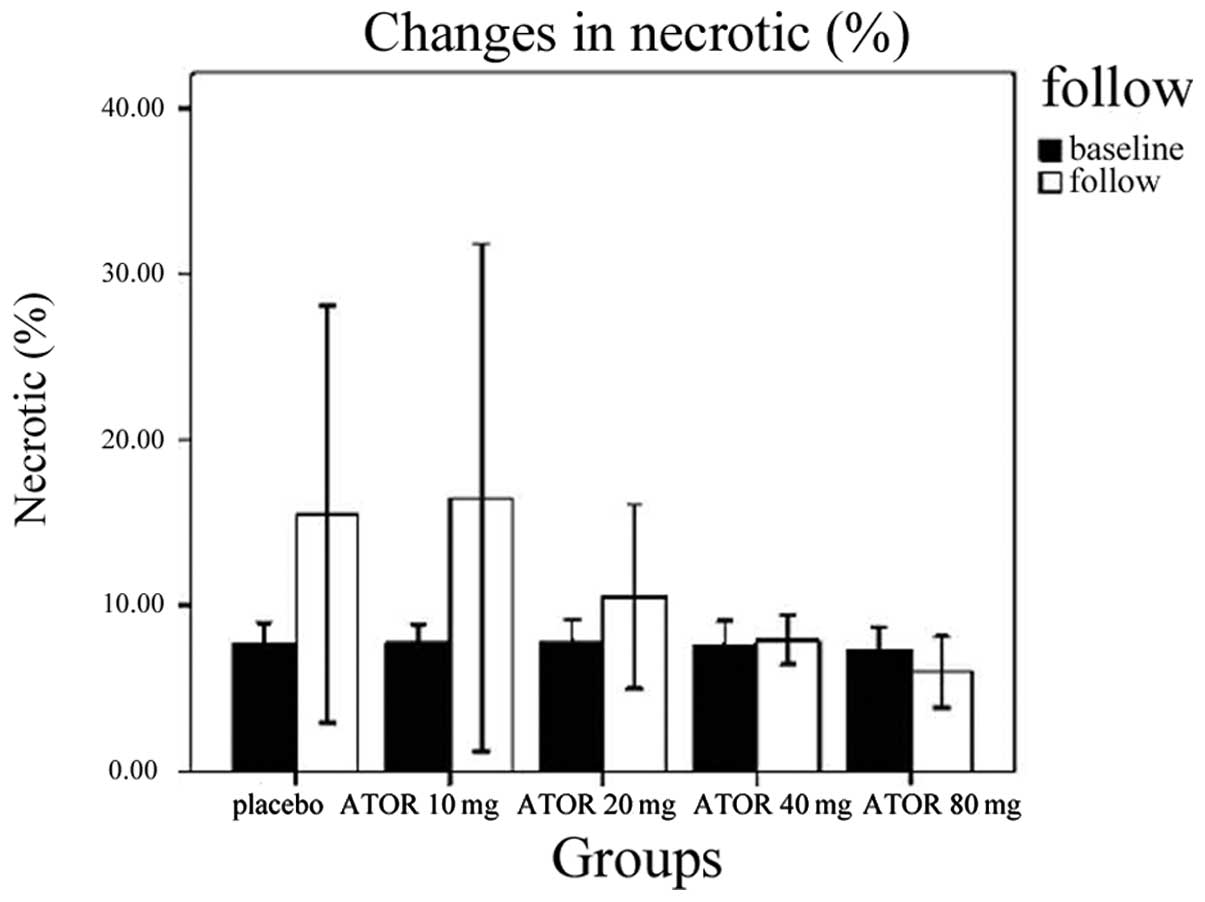 |
Figure 6
|
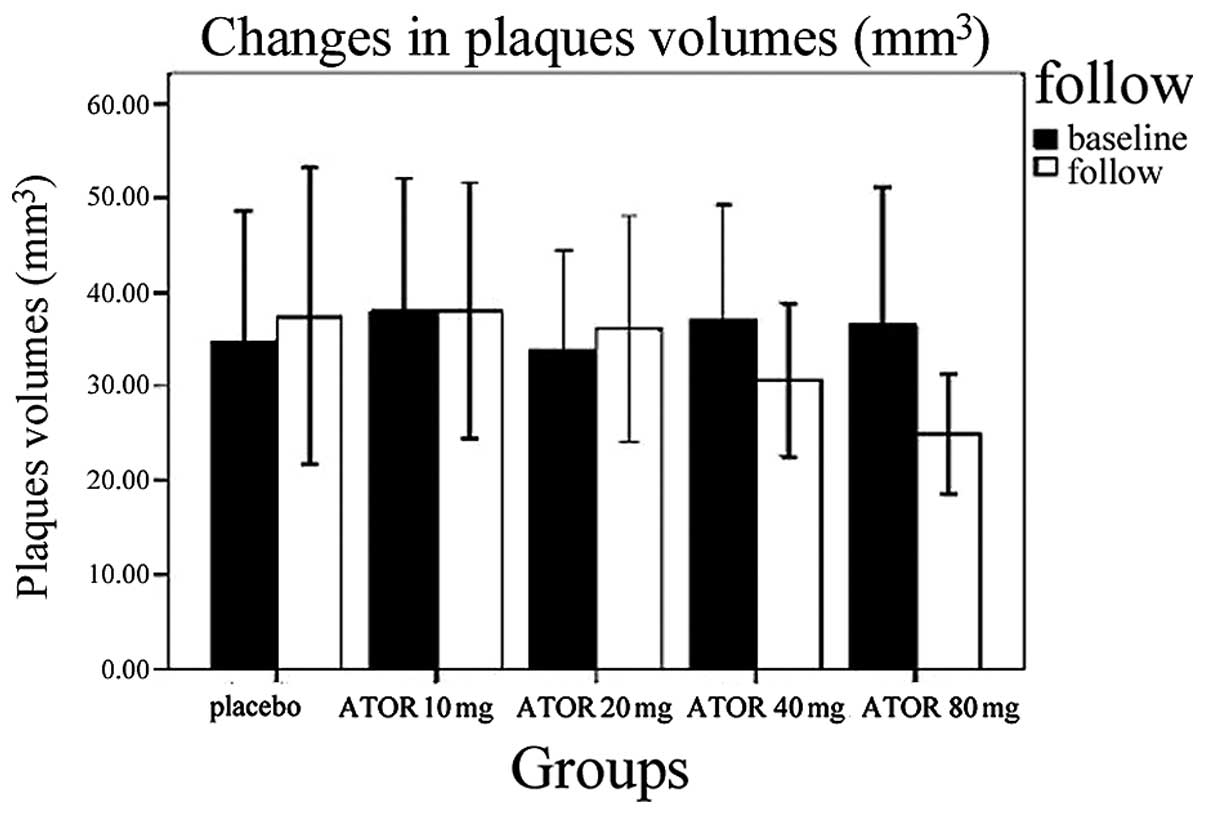 |
Figure 7
|
View References
|
1
|
Schwartz GG, Olsson AG, Ezekowitz MD, et
al Myocardial Ischemia Reduction with Aggressive Cholesterol
Lowering (MIRACL) Study Investigators: Effects of atorvastatin on
early recurrent ischemic events in acute coronary syndromes: the
MIRACL study: a randomized controlled trial. JAMA. 285:1711–1718.
2001. View Article : Google Scholar : PubMed/NCBI
|
|
2
|
Ray KK, Cannon CP, McCabe CH, et al PROVE
IT-TIMI 22 Investigators: Early and late benefits of high-dose
atorvastatin in patients with acute coronary syndromes: results
from the PROVE IT-TIMI 22 trial. J Am Coll Cardiol. 46:1405–1410.
2005. View Article : Google Scholar : PubMed/NCBI
|
|
3
|
Ishizu T, Seo Y, Machino T, et al:
Prognostic impact of plaque echolucency in combination with
inflammatory biomarkers on cardiovascular outcomes of coronary
artery disease patients receiving optimal medical therapy.
Atherosclerosis. 216:120–124. 2011. View Article : Google Scholar
|
|
4
|
Downs JR, Clearfield M, Weis S, et al:
Primary prevention of acute coronary events with lovastatin in men
and women with average cholesterol levels: results of
AFCAPS/TexCAPS. Air Force/Texas Coronary Atherosclerosis Prevention
Study. JAMA. 279:1615–1622. 1998. View Article : Google Scholar
|
|
5
|
Yokoi H, Nobuyoshi M, Mitsudo K, Kawaguchi
A and Yamamoto A; ATHEROMA Study Investigators: Three-year
follow-up results of angiographic intervention trial using an
HMG-CoA reductase inhibitor to evaluate retardation of obstructive
multiple atheroma (ATHEROMA) study. Circ J. 69:875–883. 2005.
|
|
6
|
Ebrahimi R, Saleh J, Toggart E, et al:
Effect of preprocedural statin use on procedural myocardial
infarction and major cardiac adverse events in percutaneous
coronary intervention: a meta-analysis. J Invasive Cardiol.
20:292–295. 2008.
|
|
7
|
Cahoon WD Jr and Crouch MA: Preprocedural
statin therapy in percutaneous coronary intervention. Ann
Pharmacother. 41:1687–1693. 2007. View Article : Google Scholar : PubMed/NCBI
|
|
8
|
Ko DT, Wijerysundera HC, Yun L, Austin PC,
Cantor WJ and Tu JV: Effectiveness of preprocedural statin therapy
on clinical outcomes for patients with stable coronary artery
disease after percutaneous coronary interventions. Circ Cardiovasc
Qual Outcomes. 4:459–466. 2011. View Article : Google Scholar : PubMed/NCBI
|
|
9
|
Wakabayashi K, Mintz G, Delhaye C, et al:
In vivo virtual histology intravascular ultrasound comparison of
neointimal hyperplasia within drug-eluting-versus bare metal
stents. J Invasive Cardiol. 23:262–268. 2011.
|
|
10
|
Mintz GS, Nissen SE, Anderson WD, et al:
American College of Cardiology clinical expert consensus document
on standards for acquisition, measurement and reporting of
intravascular ultrasound studies (IVUS). A report of the American
College of Cardiology Task Force on Clinical Expert Consensus
Documents. J Am Coll Cardiol. 37:1478–1492. 2001.
|
|
11
|
Schoenhagen P, Sapp K, Tuzcu EM, et al:
Variability of area measurements obtained with different
intravascular ultrasound catheter systems: Impact on clinical
trials and a method for accurate calibration. J Am Soc
Echocardiogr. 16:277–284. 2003. View Article : Google Scholar
|
|
12
|
Nasu K, Tsuchikane E, Katoh O, et al:
Effect of fluvastatin on progression of coronary atherosclerotic
plaque evaluated by virtual histology intravascular ultrasound.
JACC Cardiovasc Interv. 2:689–696. 2009. View Article : Google Scholar : PubMed/NCBI
|
|
13
|
Capurso A: The promise of statins. Ital
Heart J. (Suppl 2): 224–229. 2001.(In Italian).
|
|
14
|
Parolari A, Tremoli E, Cavallotti L, et
al: Do statins improve outcomes and delay the progression of
non-rheumatic calcific aortic stenosis? Heart. 97:523–529. 2011.
View Article : Google Scholar : PubMed/NCBI
|
|
15
|
van der Loo B, Spring S and Koppensteiner
R: High-dose ATOR treatment in patients with peripheral arterial
disease: effects on platelet aggregation, blood rheology and plasma
homocysteine. Clin Hemorheol Microcirc. 47:241–251. 2011.PubMed/NCBI
|
|
16
|
Murphy SA, Cannon CP, Wiviott SD, McCabe
CH and Braunwald E: Reduction in recurrent cardiovascular events
with intensive lipid-lowering statin therapy compared with moderate
lipid-lowering statin therapy after acute coronary syndromes from
the PROVE IT-TIMI 22 (Pravastatin or Atorvastatin Evaluation and
Infection Therapy-Thrombolysis in Myocardial Infarction 22) trial.
J Am Coll Cardiol. 54:2358–2362. 2009.
|
|
17
|
Kinlay S, Schwartz GG, Olsson AG, et al
Myocardial Ischemia Reduction with Aggressive Cholesterol Lowering
(MIRACL) Study Investigators: Inflammation, statin therapy, and
risk of stroke after an acute coronary syndrome in the MIRACL
study. Arterioscler Thromb Vasc Biol. 28:142–147. 2008. View Article : Google Scholar : PubMed/NCBI
|
|
18
|
Baigent C, Keech A, Kearney PM, et al
Cholesterol Treatment Trialists’ (CTT) Collaborators: Efficacy and
safety of cholesterol-lowering treatment: prospective meta-analysis
of data from 90,056 participants in 14 randomised trials of
statins. Lancet. 366:1267–1278. 2005. View Article : Google Scholar : PubMed/NCBI
|
|
19
|
Tziakas DN, Chalikias GK, Stakos D, et al:
Statin use is associated with a significant reduction in
cholesterol content oferythrocyte membranes. A novel pleiotropic
effect? Cardiovasc Drugs Ther. 23:471–480. 2009. View Article : Google Scholar
|
|
20
|
Chan DK, O’Rourke F, Shen Q, Mak JC and
Hung WT: Meta-analysis of the cardiovascular benefits of intensive
lipid lowering with statins. Acta Neurol Scand. 124:188–195. 2011.
View Article : Google Scholar : PubMed/NCBI
|





















